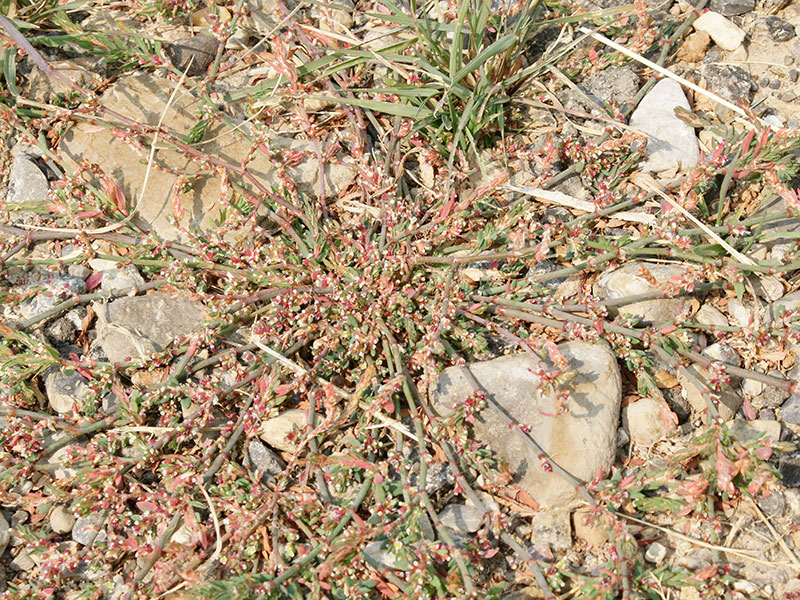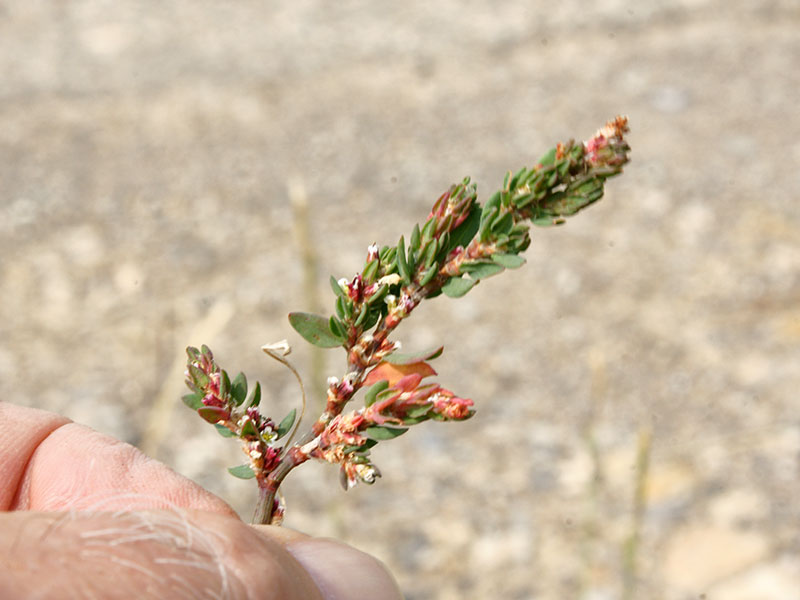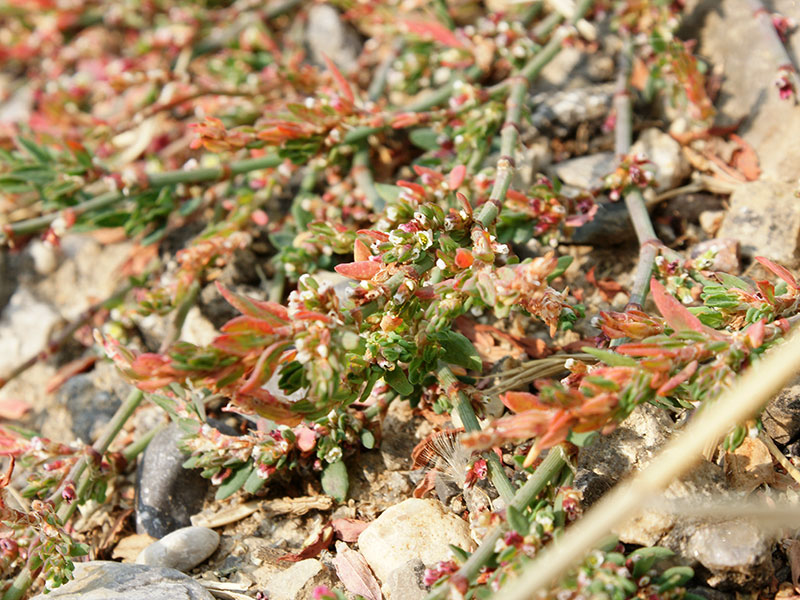Polygonum aviculare / prostrate knotweed
- long, prostrate stems around a central point
- copious red-edged white flowers
- small green leaves
- along roadsides, parking lots and wherever trampling occurs
- an ugly weed you’ll see on most of your walks around town
Also known as: birdweed, pigweed, lowgrass, common knotgrass, wiregrass, wireweed, matweed, doorweed, smartweed
Synonym: Polygonum arenastrum
Prostrate knotweed an annual or short lived perennial and, believe it or not, is prostrate. Its most common common name comes from the tiny bumps or “knots” where the leaves emerge from the stems. It is immediately recognizable by its long stems, all along the surface of whatever it calls soil. The highly branched stems form a mat, spreading out as much as 3 or 4 feet from a central hub. The stems and leaves are green, at least until they start to turn red in the fall. Overall, however, the plants may look red because they are totally covered with teeny red-sepaled flowers.
The consensus throughout the internet seems to be that the plant is ugly. With whatever adjectives you might want to attach. But ugly. On the other hand, like other weeds on this site, prostrate knotweed occupies habitats that no other plants can. These include fields and wastelands, driveways and sidewalks, cracks in asphalt, in front of soccer goals. Basically it grows anywhere where the soil has been compacted beyond redemption, and is therefore anaerobic and low in nutrients. Its roots are extremely fine and can grow through even the most compacted soils.
Prostrate knotweed germinates very early in the season. It is among the first seedlings you might see, and they look “sort of” like grass (hence a number of the common names). Because of its growth form, it doesn’t compete well with anything taller, so if something (or someone) aerates the soil, it is likely to disappear, at least over time.
Once you have identified this plant the first time, you will likely pay it little attention. Thus, you might not actually see its white flowers with pink or red margins. You might not see that these teeny inconspicuous parts are at the top of short stalks that grow from the leaf bases, or that they grow in clusters of two to eight. I mean, why would you. It’s an ugly weed.
On the other hand, you might notice that it blooms all summer and into the fall. By mid-September in the Valley, some of the individuals begin to senesce and the stems turn more brown or red than green. Other individuals remain green longer into the fall, even after frosts. You might notice this stuff because prostrate knotweed is still around long after almost everything else is brown and crispy.
Looking more closely at the leaves, they are hairless, short-stalked, and very small, from 1/5 to maybe 4/5 of an inch long. They are somewhat elliptical, especially toward the bases of the stems, but you won’t need to see them anyway to identify the plant.
The fruit of prostrate knapweed is a very very small nut, and each plant produces copious quantities of them. They need light to germinate, i.e. they need to be on the soil surface. However, they can stay viable in the seed bank for years, just waiting for you to scuff your feet over the dirt.
Interesting bits – prostrate knotweed may be confused with another weed with a similar growth form, prostrate spurge. While I have not yet seen this in the Valley, a very simple way to tell the difference is that the spurge exudes a milky white sap when its stem is broken or you pull a leaf off.
Despite the huge number of sites discussion knotweed control and its general insensitivity to herbicides, the plant is edible. It has been used as an ingredient in porridge (in Germany), and in soups and hot pots (in Vietnam). I found one site touting it as the basis for a pesto, but noting that your pesto will be green and taste like whatever else you put in, i.e. the knotweed itself doesn’t taste like much.
And finally, should you desire, you can actually buy seeds of prostrate knotweed on eBay and amazon.com. Why? It’s sold as an ancient medicinal plant. Like many other “medicinals”, it has seemingly been used to treat everything. And like most of them, there is “insufficient evidence to rate it as effective.”
| Color | |
|---|---|
| Family | |
| Blossom size | |
| Inflorescence size | |
| When? | |
| Where? |


